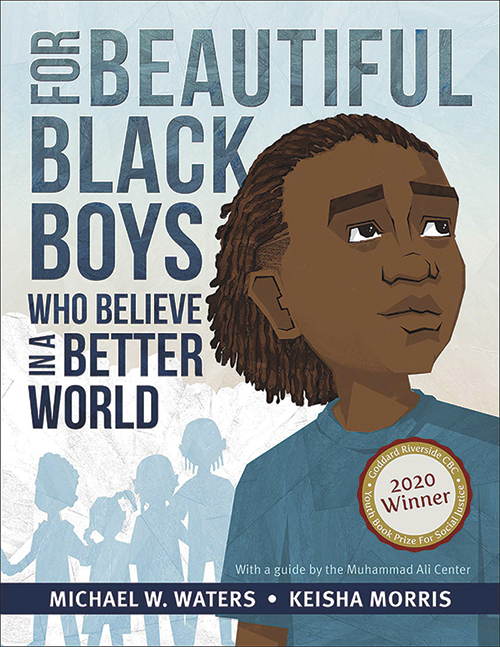
For Beautiful Black Boys Who Believe in a Better World
Reviewed by Jerry Mizell Williams
May 1, 2021
By Michael W. Waters, illustrated by Keisha Morris. Flyaway Books, 2020. 40 pages. $18/hardcover; $14/eBook. Recommended for ages 6–10.
Recurring episodes of violence pervade the consciousness of a young African American boy. What disturbs Jeremiah’s innocence is a string of killings occasioned by repeated gun violence. Images on his father’s computer and in print media shape his knowledge of events: Trayvon Martin, Michael Brown, nine members of Mother Emanuel AME Church in South Carolina, Alton Sterling, Philando Castile, five Dallas police officers, and Jordan Edwards. Young Jeremiah tries to comprehend: “Why?” While at first the father’s persistent retort of “[i]t doesn’t make sense” seems perfunctory, we read between the lines that the parents, charged with explaining the tragedies, are aggrieved and also struggling with the harsh reality that each murder has now intruded into their quotidian existence. The parents describe a variety of efforts in which they have participated in order to transform society, including vigils and protest marches. Reticent Jeremiah, whose prolonged silences are respected, requires time and space to explore his feelings; following discernment, he emerges ready to discuss his thoughts. Spirited by the family’s exchange, Jeremiah realizes he and his age group can be agents of change to “make the world a better place.”
Waters has translated his personal family dilemma into an instructive publication. He treads without apprehension where authors of children’s literature often do not. For a larger reading public, he tackles with frankness a sensitive and uncomfortable subject with which parents and most educators of African American children are familiar. The sociocultural, historical, and political catalyst for the story is decades of violence that gave rise to Black Lives Matter, although that movement is not mentioned in print. The story is an open invitation to adults to engage children about racism and related social imperatives. The discussion guide, created by the Muhammad Ali Center in Louisville, Ky., offers points to consider in preparing for dialogue in a safe space, how to speak about race and violence in the classroom, and suggests ways in which children can make a difference and effect change. For adults, there are complex questions embedded in the guide, such as how do we contextualize killings related not only to police shootings but also to vigilante/stand-your-ground homicides, mass murder, as well as those borne out of racial profiling and deeds of White supremacy. It is weighty subject matter—but far from inscrutable—to unpack at home and at school (and in Quaker meetings). This is where a guide can facilitate “courageous conversations” between children and adults. With large, colorful illustrations that skillfully capture the narrative in action, Waters gives young readers a tale of hope, and adults a vehicle to listen to and “make sense” of what children express about the world they live in and to which they will contribute.
Jerry Mizell Williams is a member of Green Street Meeting in Philadelphia, Pa. He is the author of numerous books, articles, and book reviews on colonial Latin America and matters of faith.


